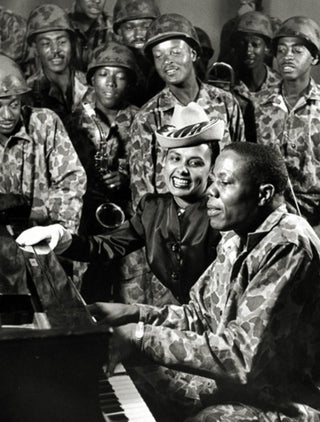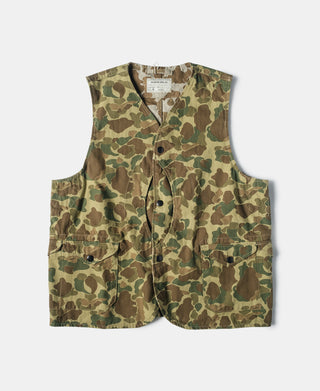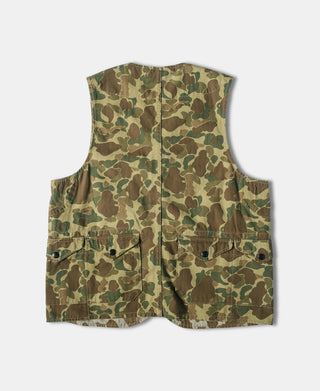Herringbone Cotton Camouflage Assault Vest (Modified)
- Unit price
- /per
Free Shipping over £79 + 30-day Returns.
Model
- 5' 10", 159lbs / 178cm, 72.5kg. Size 38.
Pairs well with
Adding product to your cart
-
Bronson designed the assault combat vest based on a bold and rational assumption of the practical needs of mobile operations during World War II, taking into account the changing geography and weather of the Pacific Theater. It incorporates the functional characteristics of the hunting vest, and each design meets the functional requirements. Includes functional design for storing and retrieving items. The details of the half-moon pocket on the chest are derived from the old-fashioned hunting vest, with three patch pockets on each side of the waist, double-sided camouflage, both sides can be worn, multiple reinforcement reinforcement, durable.
-
**Model - 5' 10", 159lbs / 178cm, 72.5kg. Size 38.**
Please use this info as a general guide as measurements are approximate.
Size Shoulder Chest S 13.6" / 34.5 cm 40.6" / 103 cm M 14.2" / 36 cm 42.5" / 108 cm L 14.8" / 37.5 cm 44.5" / 113 cm XL 15.4" / 39 cm 46.5" / 118 cm XXL 15.9" / 40.5 cm 48.4" / 123 cm
Size Sleeve Length S - 24.8" / 63 cm M - 25.4" / 64.5 cm L - 26" / 66 cm XL - 26.6" / 67.5 cm XXL - 27.2" / 69 cm In order to best determine fit, it may be helpful to compare our garment’s measurements to a similar garment you already own. Lay your garment on a flat surface and take all measurements from the outside of the garment.
Click here to check out our Garment Measuring Guide.
** If you are still confused, you can Contact Us to help you choose the size. **
-
- V-neck.
- Snapped button placket.
- Half-arc “Game Pocket” at chest. Three patch pockets on each side of the waist.
- Reversible wearing.
- 10 oz. cotton herringbone, 100% cotton.
- Machine washable.
-
- Machine washable.
Bronson designed the assault combat vest based on a bold and rational assumption of the practical needs of mobile operations during World War II, taking into account the changing geography and weather of the Pacific Theater. It incorporates the functional characteristics of the hunting vest, and each design meets the functional requirements. Includes functional design for storing and retrieving items. The details of the half-moon pocket on the chest are derived from the old-fashioned hunting vest, with three patch pockets on each side of the waist, double-sided camouflage, both sides can be worn, multiple reinforcement reinforcement, durable.
**Model - 5' 10", 159lbs / 178cm, 72.5kg. Size 38.**
Please use this info as a general guide as measurements are approximate.
| Size | Shoulder | Chest |
| S | 13.6" / 34.5 cm | 40.6" / 103 cm |
| M | 14.2" / 36 cm | 42.5" / 108 cm |
| L | 14.8" / 37.5 cm | 44.5" / 113 cm |
| XL | 15.4" / 39 cm | 46.5" / 118 cm |
| XXL | 15.9" / 40.5 cm | 48.4" / 123 cm |
| Size | Sleeve | Length |
| S | - | 24.8" / 63 cm |
| M | - | 25.4" / 64.5 cm |
| L | - | 26" / 66 cm |
| XL | - | 26.6" / 67.5 cm |
| XXL | - | 27.2" / 69 cm |
In order to best determine fit, it may be helpful to compare our garment’s measurements to a similar garment you already own. Lay your garment on a flat surface and take all measurements from the outside of the garment.
Click here to check out our Garment Measuring Guide.
** If you are still confused, you can Contact Us to help you choose the size. **
- V-neck.
- Snapped button placket.
- Half-arc “Game Pocket” at chest. Three patch pockets on each side of the waist.
- Reversible wearing.
- 10 oz. cotton herringbone, 100% cotton.
- Machine washable.
- Machine washable.

In response to combat needs, the U.S. Army Engineering Department began to develop camouflage clothing in 1940, designed by California civilian horticulturist Norvell Gillespie (Norvell Gillespie), one side of the five-color green system for jungle environment, the other side of the three-color tan system for desert environment. This pattern was applied to Herringbone Twill fabrics for printing and dyeing and for making combat suits. At this point, camouflage patterns began to be applied to American military clothing, and were also widely used in outdoor hunting and other clothing after the war, and inspired many designers to re-create and then influence the fashion world.






















